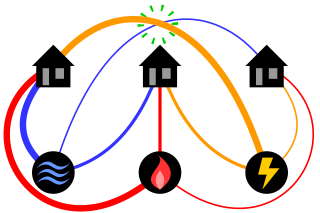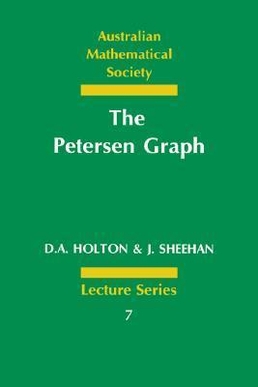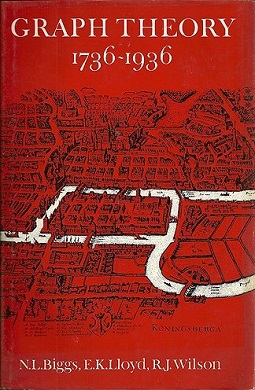
In mathematics, the four color theorem, or the four color map theorem, states that no more than four colors are required to color the regions of any map so that no two adjacent regions have the same color. Adjacent means that two regions share a common boundary of non-zero length. It was the first major theorem to be proved using a computer. Initially, this proof was not accepted by all mathematicians because the computer-assisted proof was infeasible for a human to check by hand. The proof has gained wide acceptance since then, although some doubts remain.

The classical mathematical puzzle known as the three utilities problem or sometimes water, gas and electricity asks for non-crossing connections to be drawn between three houses and three utility companies in the plane. When posing it in the early 20th century, Henry Dudeney wrote that it was already an old problem. It is an impossible puzzle: it is not possible to connect all nine lines without crossing. Versions of the problem on nonplanar surfaces such as a torus or Möbius strip, or that allow connections to pass through other houses or utilities, can be solved.
In the mathematical discipline of graph theory, the line graph of an undirected graph G is another graph L(G) that represents the adjacencies between edges of G. L(G) is constructed in the following way: for each edge in G, make a vertex in L(G); for every two edges in G that have a vertex in common, make an edge between their corresponding vertices in L(G).

Gerhard Ringel was a German mathematician. He was one of the pioneers in graph theory and contributed significantly to the proof of the Heawood conjecture, a mathematical problem closely linked with the four color theorem.
In graph theory, the thickness of a graph G is the minimum number of planar graphs into which the edges of G can be partitioned. That is, if there exists a collection of k planar graphs, all having the same set of vertices, such that the union of these planar graphs is G, then the thickness of G is at most k. In other words, the thickness of a graph is the minimum number of planar subgraphs whose union equals to graph G.
The Mathematical Coloring Book: Mathematics of Coloring and the Colorful Life of Its Creators is a book on graph coloring, Ramsey theory, and the history of development of these areas, concentrating in particular on the Hadwiger–Nelson problem and on the biography of Bartel Leendert van der Waerden. It was written by Alexander Soifer and published by Springer-Verlag in 2009 (ISBN 978-0-387-74640-1).
Using the Borsuk–Ulam Theorem: Lectures on Topological Methods in Combinatorics and Geometry is a graduate-level mathematics textbook in topological combinatorics. It describes the use of results in topology, and in particular the Borsuk–Ulam theorem, to prove theorems in combinatorics and discrete geometry. It was written by Czech mathematician Jiří Matoušek, and published in 2003 by Springer-Verlag in their Universitext series (ISBN 978-3-540-00362-5).

A Guide to the Classification Theorem for Compact Surfaces is a textbook in topology, on the classification of two-dimensional surfaces. It was written by Jean Gallier and Dianna Xu, and published in 2013 by Springer-Verlag as volume 9 of their Geometry and Computing series. The Basic Library List Committee of the Mathematical Association of America has recommended its inclusion in undergraduate mathematics libraries.
Art Gallery Theorems and Algorithms is a mathematical monograph on topics related to the art gallery problem, on finding positions for guards within a polygonal museum floorplan so that all points of the museum are visible to at least one guard, and on related problems in computational geometry concerning polygons. It was written by Joseph O'Rourke, and published in 1987 in the International Series of Monographs on Computer Science of the Oxford University Press. Only 1000 copies were produced before the book went out of print, so to keep this material accessible O'Rourke has made a pdf version of the book available online.
Polyhedra is a book on polyhedra, by Peter R. Cromwell. It was published by in 1997 by the Cambridge University Press, with an unrevised paperback edition in 1999.
Euler's Gem: The Polyhedron Formula and the Birth of Topology is a book on the formula for the Euler characteristic of convex polyhedra and its connections to the history of topology. It was written by David Richeson and published in 2008 by the Princeton University Press, with a paperback edition in 2012. It won the 2010 Euler Book Prize of the Mathematical Association of America.
Introduction to Circle Packing: The Theory of Discrete Analytic Functions is a mathematical monograph concerning systems of tangent circles and the circle packing theorem. It was written by Kenneth Stephenson and published in 2005 by the Cambridge University Press.

Crossing Numbers of Graphs is a book in mathematics, on the minimum number of edge crossings needed in graph drawings. It was written by Marcus Schaefer, a professor of computer science at DePaul University, and published in 2018 by the CRC Press in their book series Discrete Mathematics and its Applications.

The Petersen Graph is a mathematics book about the Petersen graph and its applications in graph theory. It was written by Derek Holton and John Sheehan, and published in 1993 by the Cambridge University Press as volume 7 in their Australian Mathematical Society Lecture Series.

Graph Theory, 1736–1936 is a book in the history of mathematics on graph theory. It focuses on the foundational documents of the field, beginning with the 1736 paper of Leonhard Euler on the Seven Bridges of Königsberg and ending with the first textbook on the subject, published in 1936 by Dénes Kőnig. Graph Theory, 1736–1936 was edited by Norman L. Biggs, E. Keith Lloyd, and Robin J. Wilson, and published in 1976 by the Clarendon Press. The Oxford University Press published a paperback second edition in 1986, with a corrected reprint in 1998.
Combinatorics: The Rota Way is a mathematics textbook on algebraic combinatorics, based on the lectures and lecture notes of Gian-Carlo Rota in his courses at the Massachusetts Institute of Technology. It was put into book form by Joseph P. S. Kung and Catherine Yan, two of Rota's students, and published in 2009 by the Cambridge University Press in their Cambridge Mathematical Library book series, listing Kung, Rota, and Yan as its authors. The Basic Library List Committee of the Mathematical Association of America has suggested its inclusion in undergraduate mathematics libraries.

Incidence and Symmetry in Design and Architecture is a book on symmetry, graph theory, and their applications in architecture, aimed at architecture students. It was written by Jenny Baglivo and Jack E. Graver and published in 1983 by Cambridge University Press in their Cambridge Urban and Architectural Studies book series. It won an Alpha Sigma Nu Book Award in 1983, and has been recommended for undergraduate mathematics libraries by the Basic Library List Committee of the Mathematical Association of America.
Introduction to Lattices and Order is a mathematical textbook on order theory by Brian A. Davey and Hilary Priestley. It was published by the Cambridge University Press in their Cambridge Mathematical Textbooks series in 1990, with a second edition in 2002. The second edition is significantly different in its topics and organization, and was revised to incorporate recent developments in the area, especially in its applications to computer science. The Basic Library List Committee of the Mathematical Association of America has suggested its inclusion in undergraduate mathematics libraries.
Independence Theory in Combinatorics: An Introductory Account with Applications to Graphs and Transversals is an undergraduate-level mathematics textbook on the theory of matroids. It was written by Victor Bryant and Hazel Perfect, and published in 1980 by Chapman & Hall.
The Earth–Moon problem is an unsolved problem on graph coloring in mathematics. It is an extension of the planar map coloring problem, and was posed by Gerhard Ringel in 1959. An intuitive form of the problem asks how many colors are needed to color political maps of the Earth and Moon, in a hypothetical future where each Earth country has a Moon colony which must be given the same color. In mathematical terms, it seeks the chromatic number of biplanar graphs. It is known that this number is at least 9 and at most 12.








